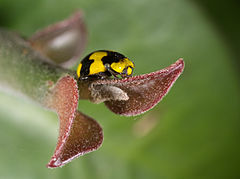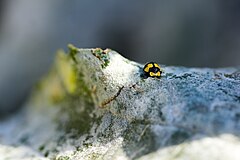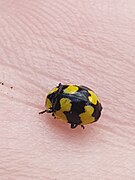Illeis galbula
| Illeis galbula | |
|---|---|

| |
| Scientific classification | |
| Domain: | Eukaryota |
| Kingdom: | Animalia |
| Phylum: | Arthropoda |
| Class: | Insecta |
| Order: | Coleoptera |
| Suborder: | Polyphaga |
| Infraorder: | Cucujiformia |
| Family: | Coccinellidae |
| Genus: | Illeis |
| Species: | I. galbula
|
| Binomial name | |
| Illeis galbula (Mulsant, 1850)
| |
| Synonyms[1] | |
| |
Illeis galbula, the fungus-eating ladybird, is a species of beetle in the family Coccinellidae.
Description
Adults are 4-5mm in size, while the larvae are between 8 and 10mm.[2] Adults are black with bright yellow markings.[3] Larvae are grey with black tubercles covered with short spines.[3] The pupa is pale yellow with black tubercles and lateral spurs.[3]
Behaviour
During the day it is fast moving and readily flies or drops when disturbed.[2] The pupa are active and often stand on end.[2] Adult and larval fungus-eating ladybirds are often found in gardens where they eat powdery mildew on cucurbit crops like pumpkin and zucchini.[4] In Australia, overwintering adults feed on pollen of wattles and privet species during spring.[3]
Distribution
This species is native to Eastern Australia.[3] Fungus-eating ladybirds are a non-native species in the North Island of New Zealand, first introduced to Auckland in 1985.[3] They are also found in New Guinea.[3]
Gallery
-
Larval form
-
Fungus-eating ladybird, Binalong Bay, Australia
-
Fungus-eating ladybird eating powdery mildew on zucchini leaf
-
Illeis galbula on a hand
References
- ^ "Illeis galbula". Retrieved 2008-12-21.
- ^ a b c "Fungus-eating Ladybird - Illeis galbula". Retrieved 2008-12-21.
- ^ a b c d e f g N A Martin (2017). "Fungus-eating ladybird - Illeis (Leptothea) galbula". Landcare Research. Retrieved 2021-02-18..
- ^ Crowe, A. (2002). Which New Zealand Insect?. Auckland, N.Z.: Penguin. p. 47. ISBN 0-14-100636-6.




